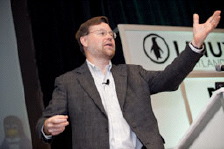There are three big areas of opportunity for Linux in the near future: cloud computing, mainframe, and Linux’ future on the desktop. That was one of the main messages of a keynote from IBM’s Dr. Robert Sutor, who addressed the morning crowd at LinuxCon Monday.
 Sutor, VP of Linux and Open Source, initially walked the crowd through why he believes Linux is already an effective cloud platform. A good cloud OS should provide cloud-friendly applications; storage, processor, and platform resources; standard APIs, and excellent quality of service. All of these are aspects Linux has now, Sutor explained to the crowd.
Sutor, VP of Linux and Open Source, initially walked the crowd through why he believes Linux is already an effective cloud platform. A good cloud OS should provide cloud-friendly applications; storage, processor, and platform resources; standard APIs, and excellent quality of service. All of these are aspects Linux has now, Sutor explained to the crowd.
Because Linux supports multiple hardware platforms, it can be implent on all sorts of devices, from embedded devices to supercomputers. It is also easily virtualized, both as a guest and host OS. It’s modularity and open development allow it to be very nimble and flexible.
The virtualization aspect of Linux is a big part of the reason Linux is well-suited for the mainframe. In fact, Sutor explained, IBM began researching virtualization in the 1970s just for the purposes of increasing the efficiency of its product line at the time. While the technology was slow to take off then, IBM hopes to capitalize on it hugely now, pushing energy and cost savings to its customers with more efficient datacenters.
It was Sutor’s remarks on the desktop that drew the most commentary from attendees and the media.
Sutor outlined several possible scenarios for Linux on the desktop:
- The Linux desktop goes away.
- Users stop using desktops, so who cares?
- The Linux desktop becomes a tactic instead of a strategy.
- One Linux desktop distribution ends up with 90% market share among those using Linux desktops.
- One Linux desktop distribution ends up with 90% market share among all desktops.
Sutor also joked that one possible future would be equal 33% / 33% / 33% parity with Microsoft Windows/Apple Mac OS X/Linux, plus or minus 32.9%.
These remarks on their own were broad enough not to raise eyebrows, but Sutor’s next statement did: “I think making it a complete drop-in replacement is a dead-end strategy,” he said, referring to Linux as a Windows replacement.
What was not picked up as much in the media was his next sentence: “we need to make something better.”
Sutor did not seem to be advocating the end of the Linux desktop, but rather was making a call to the desktop community to stop following Windows and OS X and begin a unique line of innovation.
If this were done, Linux on the desktop would be a viable contender for this segment of IT, Sutor maintained.


